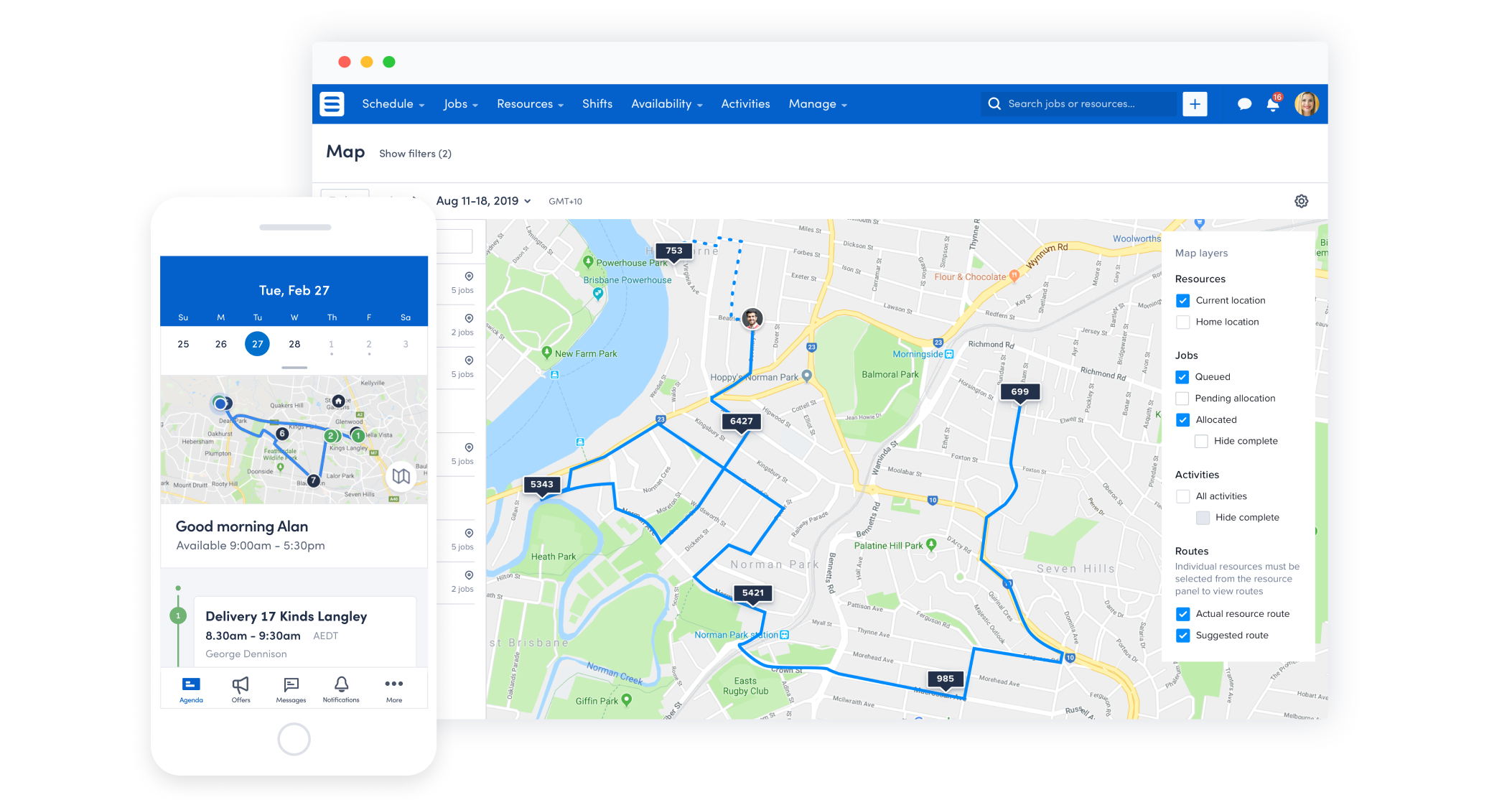How To Drive Customer Satisfaction through Effective Field Service Management
As the landscape of the field service industry evolves, so do the barriers that often prevent mobile workers from delivering superior customer service. Field workers are the face of your business. They’re your most valuable resource in the battle to gain customer happiness and loyalty, but preparing them to do so can be a difficult feat.
Today’s consumers have plenty of options and instant access to customer reviews—so they expect excellent customer service at every turn. Many customers are willing to switch to a competing service specifically because of bad customer service. And when they switch, they don’t go quietly, as 62% of customers claim that they share their negative experiences with others.
Ensuring customer satisfaction in the field service industry is crucial, but it’s also especially challenging. Weak scheduling and dispatching processes, communication issues, and a lack of workforce visibility result in operational inefficiencies that threaten a business’s ability to provide excellent customer service.
The good news is that by optimizing these components of your field service organization (and leveraging the right tools for support), you can boost your operational efficiency, enhance the employee experience, and, ultimately, improve customer satisfaction.
Why Customer Service Matters for Field Service
Field service management (FSM) focuses on empowering your deskless workers to do their best work. Traditional FSM relied on tools and processes for optimizing metrics like worker utilization, fix-time rates, and windshield services to measure and achieve success. This was grounded in the need to enhance employee performance for those ‘classic’ break/fix or maintenance use cases.
But those tools and processes of the past are no longer enough to remain competitive in the field service industry, which has expanded to include new industries (e.g. mobile healthcare, real estate, and sales), blended workforces, and flexible work patterns. The modern, global, and ever-changing business market has become a breeding ground for competitors, all looking to meet—or exceed—increased customer expectations.
This shift has led to a new approach to FSM and the advent of modern tools that aim to better support deskless workers, who, in turn, can better serve their customers. With the field service management market value expected to reach $5.9 billion by 2024, it’s no wonder why 72% of field service organizations are prioritizing improvements in customer satisfaction. That level of market growth means two things: a more competitive landscape, and more opportunities for organizations that leverage the strategies and tools required for operational efficiency.
But if your field workers aren’t ready (and willing) to delight customers at every interaction, your business could be left in the dust by its customer-centric competitors.
How to Measure or Assess Customer Satisfaction
A critical component of your strategy to improve customer satisfaction should include methods for measuring its success. Here are some helpful techniques for assessing your team’s ability to
provide best-in-class experiences during every customer interaction:
- Customer surveys – By actively seeking feedback from customers, your business can demonstrate how much it values delivering an outstanding experience. Customer surveys are a great way to get an accurate pulse on whether or not mobile workers are meeting client expectations.
Leading field service organizations have invested in improving the digital experience for customers, with tools for instant feedback via chatbots and surveys. This helps customers to feel more engaged with and supported by your brand than, say, having to call customer service and wait on hold to speak to a representative. It also enables your team to quickly identify and resolve issues, answer questions, and continuously improve their processes in a proactive manner.
You can streamline the process of collecting surveys by implementing tools that automatically prompt customers to provide their feedback once a job is completed. Be sure to use short, direct questions that are simple to answer to incentivize survey completion. And the buck shouldn’t stop there, so make sure the tool you use offers easy access to that feedback for relevant deskless workers.
- Social Listening – 74% of millennials say their perception of a brand improves when it’s clear that the company responds to social media inquiries. And since millennials account for 72.1 million of the US population alone, that number is nothing to scoff at.
It’s essential for field service companies to listen to their customer base where they want to be heard. Your organization’s social media profiles hold more value than just their marketing and advertising power. They’re also an effective channel for addressing concerns, providing helpful resources, and uncovering larger operational issues.
Social listening should also extend to broader research, where you can gain key insights around customer expectations, competitors’ customer service strategies, and how you can tweak your own approach for a competitive edge.
- Business data, stats, and reporting – Qualitative feedback is great for evaluating customer sentiments, but you also need to evaluate customer satisfaction through hard data. These quantitative measurements help you understand how quickly your field workers actually get to customers, whether or not they get the job done right the first time, how many customers they’ve served in a given period of time, and more—all of which impact customer satisfaction.
Make sure you assess metrics like response time, schedule adherence, rework percentage, and rate of repeat business to glean deep insights into how well your customers are being served. Then, use those metrics to identify any workflow inefficiencies or individual employee issues that might be affecting service delivery. For example, a high number of repeat visits may mean your deskless workers aren’t able to access the necessary information they need in the field to successfully complete the job. Armed with this knowledge, you can make updates to your process or tool set to overcome any existing barriers.
Competitive field service businesses use robust technology to track and analyze this data, which might otherwise be difficult to capture, connect, and report on for meaningful improvements. Intelligent FSM tools make it easy to track data, identify inefficiencies, and streamline operations for enhanced customer satisfaction.
- Feedback from field service technicians – There are myriad benefits to ensuring an excellent employee experience, and among them is a greater willingness and desire to deliver superior customer service. In fact, when employees feel recognized, they’re 4.6 times more inclined to perform at their best. Thus, it’s paramount for field service organizations to understand, value, and ameliorate any issues or concerns that their deskless workers may have.
By regularly collecting feedback from your field service technicians, you gain a first-hand perspective of service conditions. Mobile workers have needs that are unique to their dynamic roles, so if you want them to put their best foot forward with customers, start by asking them how you can better support their day-to-day functions.
Pulse surveys can be helpful, as they’re much shorter and easier to complete than engagement surveys, and can be issued more frequently than more traditional evaluations. And when taken into account alongside broader workforce metrics, this employee-level data can paint a more accurate picture of any operational roadblocks. While a slow response time might initially raise concern over scheduling issues, for example, more granular employee feedback might point to frustrations with routing tools or an inefficient dispatching process.
How to Improve Field Service Customer Satisfaction
Your field workers’ ability to ensure excellent customer service hinges on your company’s overall level of operational efficiency. Thus, to boost customer satisfaction, you must first eliminate the workflow bottlenecks and time-consuming, manual processes that prevent consistent, reliable service delivery.
Field service organizations can streamline operations and enhance customer satisfaction by following some key best practices:
Enable your technicians
Your deskless workers face day-to-day challenges that their desk-based counterparts don’t—from time-consuming field data collection, to disjointed mobile tools, to ever-changing schedules and more. If you don’t empower them with the proper tools to overcome these obstacles, you can’t expect them to be fully prepared to deliver outstanding customer service.
To better support their customer service capabilities, provide your mobile employees with tools that give them real-time, instant access to customer history, appointment details, required forms, updated schedules, and other information, regardless of where they are. That way, they can spend less time shuffling through fragmented tools to gather the information that’s pertinent to the job, and more time focusing on the customers. And, they’ll have everything they need in the field to make sure the job is completed correctly the first time, every time. As you evaluate solutions, make sure the one you choose offers real-time updates, even offline, so your deskless workers never miss a beat.
You should also ensure field data collection is as seamless as possible, so employees can capture key details without having to fill out mountains of paperwork (or enter information into a system of record when they return to the office). Some modern tools offer features for mobile data collection to make the process easier and more engaging for deskless workers and customers alike. And since 75% of consumers don’t like the idea of having field technicians in their home in the wake of the COVID-19 pandemic, make sure you invest in a tool that is capable of collecting contactless customer signatures.
Automate scheduling and dispatching to promote operational efficiency
Outdated, manual processes are time-consuming, burdensome, and error-prone, but automated solutions promise improved optimization. Scheduling and dispatching play a huge part in how you’re able to serve your customers, as they set the stage for a good or bad first impression.
If you’re still using spreadsheets or other manual tools to schedule and dispatch your field workers, you’re missing out on a clear opportunity to gain a competitive advantage. Automated scheduling and dispatching reduces human error (like double-bookings, matching a worker with the wrong skill set to a job, or miscalculating the time it will take a worker to arrive), and gives your team peace of mind that nothing is falling through the cracks.
With automation technology, the situations that leave back-office workers, deskless employees, and customers frustrated and dissatisfied are no longer a concern. These tools help you find and pair the right worker to the right job, so customers are met by qualified, prepared workers every time.
Enable real-time, proactive communication
As mobile workers travel from job to job, they often face issues with communication, which can cause unnecessary stress and render them unprepared. This is particularly challenging for field workers who must rely on a variety of fragmented tools (e.g. text messages, email, phone calls, etc.) to receive and provide updates in the field. It often results in missed appointments, unhappy employees, and poorly-served customers.
By providing a tool that unifies communication in a single, mobile-friendly app, field service organizations can alleviate the issues that otherwise threaten efficiency. Look for a tool that centralizes real-time communication between mobile workers, back-office employees, and even customers. That way, no one is left in the dark about arrival times, delays, schedule changes, updated company information, and more. At the press of a button, field workers can share their status, alert a customer that they’re running behind, or quickly shift gears in the face of a last-minute schedule change. That kind of proactive communication can mean the difference between an exceptional customer experience and one that leaves them running toward your competitors.
Promote workforce visibility
For your field service company, workforce visibility requires accurate information about your mobile workers’ skills, certifications, and preferences, but it also means having access to real-time data—like employee locations, availability, and work in progress. It’s vital for understanding individual performance, overall customer demand, and your team’s ability to meet client expectations.
But that level of transparency isn’t easy to achieve if you’re still using traditional methods to collect, update, and access information. Since 52% of field service organizations still rely on those manual, paper-based processes for data collection and maintenance, implementing powerful tools for increased visibility can help you edge out the competition.
With tools that offer transparency into day-to-day operations, quality of customer service, and workflow challenges, you can better understand what you need to adjust to succeed. Intelligent solutions even help you identify and escalate potential problems (like missed appointments, delays in service, or disappointed customers), so you can intervene before they become larger issues.
Enhance Customer Satisfaction with Modern Field Service Management Software
Assessing whether or not your field workers deliver great experiences—and streamlining operations to improve those experiences—is an essential part of successful field service management. But this can be difficult if you don’t have the proper tools for support.
Skedulo’s intelligent field service management software drives improved customer satisfaction with tools that automate scheduling and dispatching, streamline communications, and increase workforce visibility. With Skedulo, you can enhance your operational efficiency to reach more customers without sacrificing an exceptional customer experience.
Learn how the right field service management software can benefit your business, or book a demo today.




